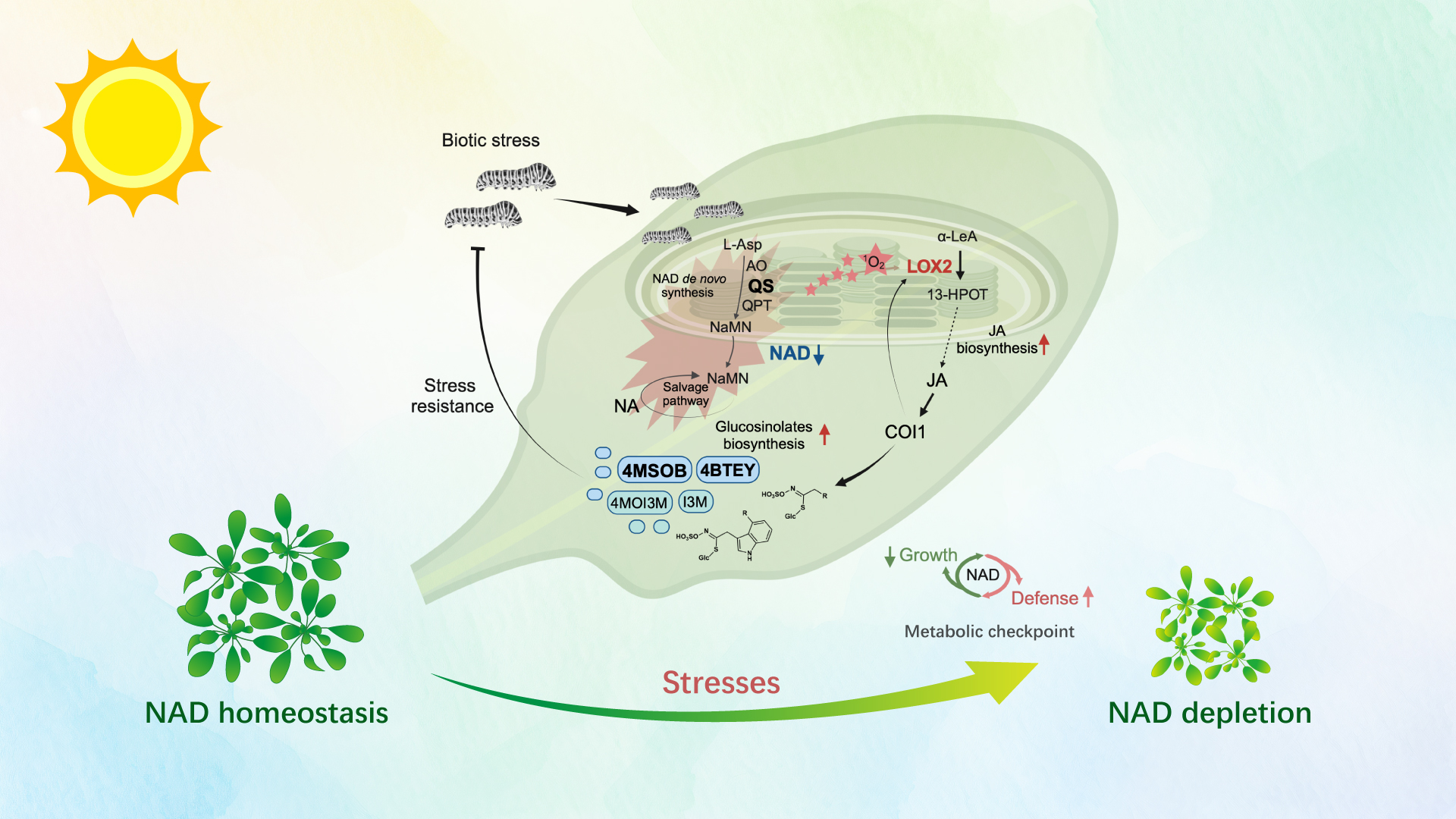Researchers reveal molecular mechanisms underpinning NAD+ deficiency-induced resistance via priming plant defense metabolism
DATE:2024-08-09
Nicotinamide adenine dinucleotide (NAD+) is a coenzyme and substrate participating in redox and energy-transferring reactions within cells. Maintaining NAD homeostasis is essential for normal plant metabolism, growth, development, and stress response. In plants, NAD+ is biosynthesized, and its levels are maintained through de novo synthesis and the salvage pathway.
Recent research has shown that NAD+ degradation products can serve as important signals triggering plant immune response. NAD+ deficiency could lead to abnormal growth and response to high salt and drought stresses, indicating NAD homeostasis plays an important role in plant growth and stress responses. Both NAD+ degradation and biosynthesis deficiency could reduce NAD content. While previous studies have primarily focused on the impacts of NAD degradation and its products on living organisms and their associated mechanisms, the impacts of NAD+ biosynthesis deficiency on plant metabolisms and resistance, as well as the corresponding mechanisms, remain unclear.

Associate Professor Ancheng Huang’s research group from the Department of Biology, School of Life Sciences at the Southern University of Science and Technology (SUSTech) has uncovered that NAD+ deficiency induces plant resistance via singlet oxygen-escalated biosynthesis of the phytohormone jasmonate, followed by the sequential priming of plant defense metabolisms.
Their work, entitled “NAD+ deficiency primes defense metabolism via 1O2-escalated jasmonate biosynthesis in plants”, has been published in Nature Communications.
The researchers employed genetics and multiomics approaches to uncover the metabolic basis of NAD+ deficiency. They found that NAD+ deficiency resulted in plant growth retardation and overaccumulation of defense metabolites, especially glucosinolates, which led to enhanced insect resistance of plants. The hyperaccumulation of glucosinolates and insect resistance phenotypes depended on the activation and signal transduction of the phytohormone jasmonate, which was found to be initiated from the first step biosynthesis pathway, i.e., hydroperoxidation of α-linolenic acid, via a burst of singlet oxygen (1O2).
Further analysis found that the sequence of NAD+ deficiency induced jasmonate activation and defense priming functions in plant response to insect infestation, indicating that the NAD+ deficiency signaling pathway is important for modulating metabolism to balance growth and defense in plants. This study reveals, for the first time, the mechanisms underlying the newly discovered signaling pathway-mediated plant resistance (to insects), i.e., “NAD+ deficiency -> singlet oxygen activation -> jasmonate biosynthesis and transduction -> defense metabolite biosynthesis”. The research group identified NAD homeostasis as a key “metabolic checkpoint” mediating plant growth and resistance.
This work offers new insights into the signal transduction mechanisms and metabolic basis underlying plant-environment interactions, laying the theoretical ground for breeding resilient plants in the future.
Dr. Yechun Hong (now Research Assistant Professor) and Ph.D. student Zongjun Yu are the joint first authors of the paper. Associate Professor Ancheng Huang is the corresponding author, and SUSTech is the sole corresponding institute. Research Assistant Professor Qian Zhou performed bioinformatics analysis, including developing the integrated omics analysis pipeline. Drs. Chunyu Chen, Yuqiong Hao, and Zhen Wang (Anhui Agricultural University) provided technical support. Chair Professor Hongwei Guo and Academician Jiankang Zhu offered additional guidance and support.
This work was supported by the National Natural Science Foundation of China (NSFC), Shenzhen Science and Technology Program, China Postdoctoral Science Foundation, SUSTech Presidential Postdoctoral Fellowship, and the Shenzhen Municipal Startup Fund. They researchers acknowledge the Core Research Facilities of SUSTech for providing technical support.
Paper link: https://www.nature.com/articles/s41467-024-51114-1
To read all stories about SUSTech science, subscribe to the monthly SUSTech Newsletter.
latest news
-
Dynamic changes in transposable elements shape human three-germ-layer differentiation
Date:2025-09-04
-
Researchers collaborate to uncover how SOD1 protects lysosome through autophagy
Date:2025-08-26
-
Researchers find 5-IP7 disrupts intestinal epithelial barrier and drives inflammation-induced colorectal cancer
Date:2025-08-26
-
Researchers decode molecular architecture and inhibition mechanism of human taurine transporter
Date:2025-08-22
